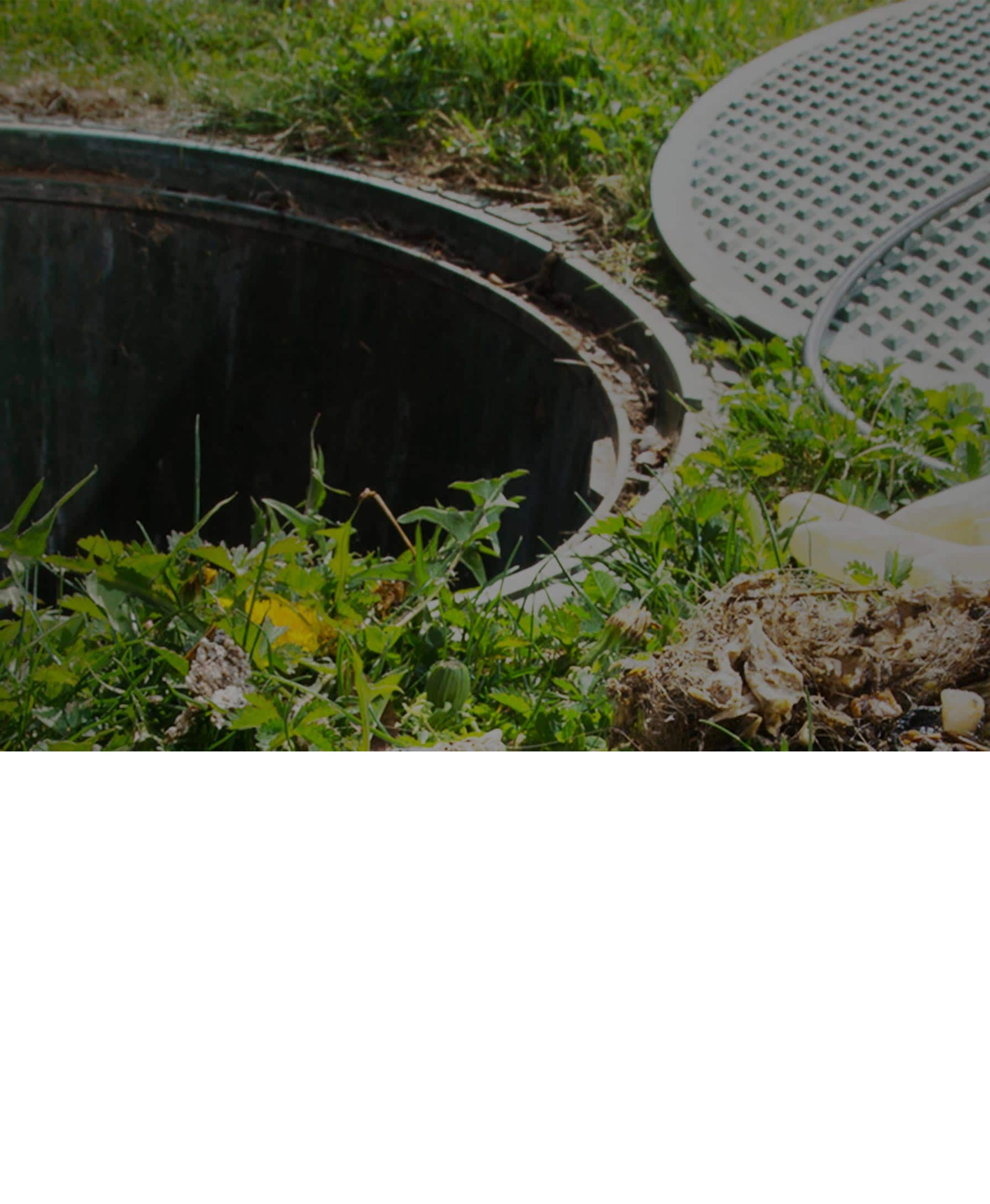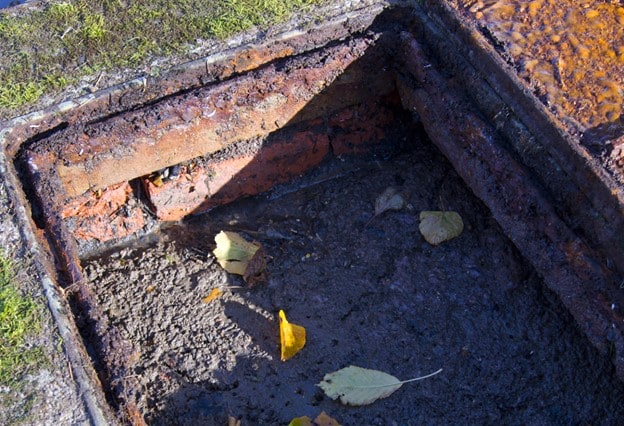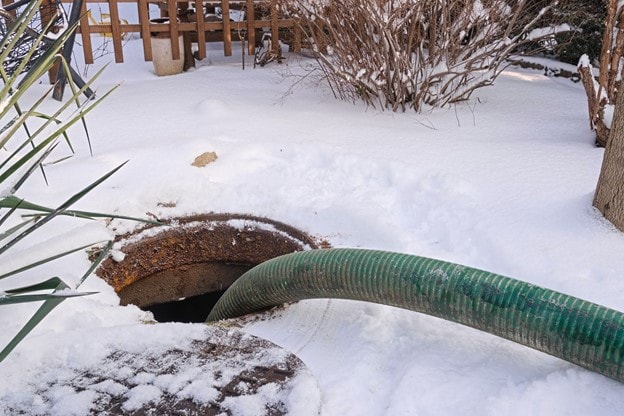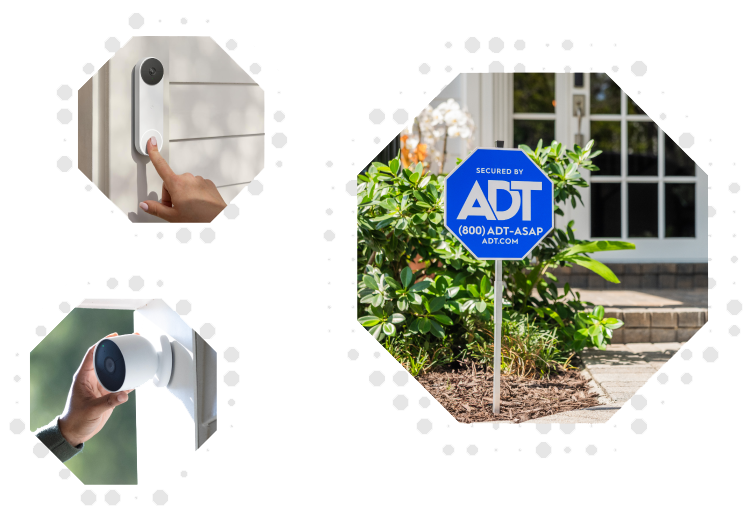6 Signs it’s Time to Empty Your Septic Tank

Many homes have a septic tank on their property, but you don’t think about it until a plumbing issue occurs.
So what is a septic tank, and what does it do?
A septic tank helps manage your wastewater and solid waste. Once it goes down the drain into the tank, it separates into wastewater that floats to the top and more solid, sludgy matter that sinks to the bottom. Perforated pipes along the leach field slowly release the liquid sewage into the surrounding soil, where it filters and disperses the liquid to change into groundwater eventually.
When it comes to your septic tank, there are things you can look out for so you know when it’s time to get it pumped.
What does a full septic tank mean?
It’s very typical for a septic tank to be full, which means it’s functioning normally! But there is a standard full range, and then there is the possibility your septic tank is clogged or overfull, both of which are not good.
There are three different ranges your septic tank system could be running at:
1. A full tank means that it is running at a normal full level. This means that the intake and outtake pipes are functioning normally, and wastewater is flowing into the septic system’s absorption or drain field. A pumped tank doesn’t mean that the tank stays empty. Once you start using your septic system again, it will return to the proper full level.
2. The tank can become full because it’s clogged with sludge. When this happens, the liquid/wastewater still flows from the outflow pipe to the drainage area, but the undissolved toilet paper or waste doesn’t break down.
3. An overfull tank is a common cause of sewage backup. It happens when your tank fills to the top with wastewater, but it is not draining properly into the absorption area. Instead, it remains in the outlet pipe, backing up and overfilling the tank.
How can you prevent a full septic tank?
Since your septic tank will always be “full,” your primary focus should be on ensuring it stays at an optimum full level. The best thing you can do is be preventative and regularly pump your system
How often should you pump your tank? The United States Environmental Protection Agency (EPA) recommends getting your septic tank pumped every 3 to 5 years to remove sludge buildup.
That number of years depends on several factors:
The size of the septic tank.
The number of people in your home.
The volume of wastewater and solid waste that your family generates
When moving into a new home, you should request documentation of the previous sewage maintenance schedule. And if you don’t have that information, it’s a good idea to go ahead and get the system pumped just to be safe.
If you wait too long between pumping your system, you could be at risk for sludge buildup and eventually damage your drainage system.


How can you tell if your septic tank is full?
The things you flush down the drain influence your septic tank system. People often throw materials down the drain that don’t break down. And that builds up!
Besides natural buildup over the years, other things can happen to your septic system that may indicate it’s time to get your system pumped or checked out by a professional.
You have trouble flushing your toilet, or it’s constantly backing up.
If all the bathrooms and drains in your home are draining slowly, or are hard to flush, this could indicate that it isn’t just a simple clog. It may be a septic tank issue. In fact, this is usually one of the first signs that your septic tank is filling up, and you should take it seriously.
Your pipes make a gurgling sound or drain very slowly.
Gurgling happens when something inside the lines traps air and prevents liquids from flowing down the drain. Air pockets form, leading to a gurgling sound.
Though this is another warning sign of a full septic tank, other things can cause these issues, too, such as your drains being blocked or clogged with dirt, hair or paper residue.
Your lawn is suddenly growing lush, green grass.
This may seem like a strange symptom of sewage backup, but if the grass around your septic tank appears healthier than the surrounding grass, this could be a sign it’s time to pump your system.
Water starts to pool in your yard.
If you’ve noticed overflowing or standing water where your septic tank is located, it may be overflowing. The main difference between wastewater and standing rainwater is that a smell accompanies wastewater.
Your home or yard smells like… well, sewage.
These odors can come from drains or toilets and they may indicate that you may have problems with your septic tank. This can happen if a clog in your system’s ventilation traps gasses.
Septic system gases consist of methane, carbon dioxide and nitrous oxide, so it’s essential to call a professional if you encounter strong sewage smells.
Sewage backup in the drains.
If you notice raw sewage coming back up in your bathtub and shower drains, you should immediately call a plumbing service or professional septic service. When the sewage is backing up to this point, it can cause damage to your home or be a health hazard to you.
A septic tank failure can happen in any home, so y be proactive with your plumbing system. If you find any of these symptoms, you should immediately call a plumber or professional septic tank service.
What should you do if your septic tank is overflowing?
If your septic tank system does overflow, you can do a few things before calling a professional to help.
If sewage starts to back up from your drains, you should immediately contact a plumber or septic tank service, as this type of waste is potentially hazardous.
1. Turn off all the water in your home and avoid using it until you access the situation.
2. Check the water level of your drain field. If there’s standing water near your septic system, it may be due to flooding.
Pro-tip: If you don’t see standing water, you can determine the water level using a soil probe. You’re looking for a test that shows the water level is rising above the septic tank.
1. Consider the current weather conditions and if that might play into an oversaturated drain field. Has there been a lot of rain the past few days? If this is the cause, you should wait a day or two to see if that remedies the situation. If not, it may be time to call a professional.
2. You should always contact professionals if your septic tank is overflowing. However, you may have to wait a few days for the ground to dry out before they can handle your situation. Mud and other debris could get into the tank and damage your tank if it’s pumped when the ground is too wet.
What are the benefits of installing commercial water detection technology?
Regular maintenance is always a good idea, but water detection technology can be helpful, especially if your septic tank is near your garage or inside your basement. A flood detector alerts you to leaking water or even sewage backup.
Add sensors next to your toilet to detect sudden overflows or near sinks. If you have a septic tank in your basement or near your garage, a water sensor may be able to alert you of any overflow into your home right when it happens, instead of several days after a sewage backup.
- Flood sensors can help you pinpoint the exact location of where the leak is occurring.
- Some flood sensors send alerts directly to your smart device to alert you as soon as a leak happens, so you can work on getting it fixed before any lasting damage occurs.
- You can place a sensor in hard-to-reach areas of your home for sewage backup detection that may otherwise go unnoticed.


What can you do if your septic tank is filling up too quickly?
If it seems like your septic tank is filling up too quickly, there are a few reasons this may be happening. Here are a few common causes of why your tank is filling up and what you can do to help prevent these issues from happening in the first place.
The tank keeps filling up with water.
If your septic system is functioning, it drains excess liquid to the designated leach field. However, if there’s more water in the tank than it can drain, the surplus water makes it harder for the solid waste to dissolve. Eventually, the solid waste can be pushed into the distribution pipes, causing a blockage; or the excess water can rise beyond normal levels in the tank.
This can occur if too much water is going down your drainage system at once, such as several household members taking a shower at once, or if you’re improperly directing drains into the septic system through downspouts.
How to prevent your tank from filling with water:
- You’ll want to ease up on the amount of water going down the drains.
- Ensure proper drainage systems and downspouts pointing away from your tank.
- Limit your household to one shower at a time.
- Wash clothes over a few days instead of back-to-back.
- You can also install efficient showerheads and faucets to help limit the water flow.
Your drain field gets clogged or frequently waterlogged.
The drain field, absorption field or leach field is the area around the septic system that allows liquids to sieve through the dirt. If you live in an area prone to rainfall or snowmelt, your drain field may have trouble draining.
How to prevent your drain field from getting waterlogged:
- Plant shallow-rooted flowers or grass over the drain field to help absorb some rainfall. It’s important to note that you should never plant anything larger since roots from shrubs or trees can damage your septic system.
- Dig ditches to divert excess rain away from your septic tank.
- Never install storm drains or gutters pointing towards your septic system.
- Minimize the use of water and drains during heavy rainfall.
- Don’t drive heavy vehicles over the drain field, as this could impact the soil and lead to it having trouble absorbing water.
Excess sludge can clog your septic system.
As we mentioned previously, this problem can occur if you don’t regularly maintain your septic system. The solid waste can clog your drain field instead of emptying properly.
To prevent sludge from accumulating:
Pump your tank every 3 to 5 years, per the manufacturer's instructions. Only flush appropriate items down the drains and toilet and avoid non-septic-safe things. Some items like wipes or cat litter may say they are flushable, but you should exercise caution and dispose of them in the trash to be safe.
Tree root growth can damage sewer pipes or drain lines and lead to backed-up drains.
Tree roots are naturally drawn to sewage and drain lines because of the water and nutrients that leach into the soil. But these roots can cause substantial damage and even potentially grow into the septic tank or pipes.
Wastewater can’t correctly drain into the ground, which could cause your lines to back up into your home. A professional will need to install new pipes or even an entire septic tank system if this happens.
How to prevent tree roots from damaging your septic system:
- Only plant grass or other shallow-rooted plants.
- Never plant trees or shrubs near your septic system.
- If your property already has plants near your tank, you should remove them.


What should you do if your septic tank freezes?
If you live in an area prone to freezing pipes, it’s possible for your septic tank to freeze, too. This can happen when the contents of the septic tank are exposed to freezing temperatures for too long. So while it’s important to maintain your septic tank year-round, it becomes especially important in the winter months.
If you notice that the toilet or drains aren’t draining coupled with your ice machine not running, or your washing machine is malfunctioning, this may be due to frozen pipes.
It's important to notify a trained professional if you believe your septic tank is frozen.
Never:
- Add any chemicals or even salt to the drains since this could damage the septic system.
- Continuously run water to keep your pipes from freezing, as this could overflow the septic tank.
- Cover your drain field with compacted mulch or heavy items like vehicles since this could compact the soil and damage the drain field.
- Add tarps or other items on top of your drain field, as this could keep water from evaporating and prevent the drain field from functioning properly.
- Try to thaw the septic system out with fire or other heating methods
How to prevent your septic tank from freezing:
- You can insulate pipes or even the septic tank itself.
○ Replace old pipes with insulated pipes.
○ Grow out the grass over the drain field during the summer for some natural insulation against frost.
○ Add 8 to 12-inches of mulch around your septic tank, pipes or drain field. Make sure to only add loose organic matter, like straw or leaves, to avoid compacting the soil. Compacted soil can lead to a malfunctioning drain field.
Pro-tip: If your septic tank is already frozen, you’ll want to avoid adding mulch until it’s thawed out.
- Make sure to use warm or hot water during colder days: Do warm loads of laundry, run the dishwasher or take hot baths.
- If you find a leaking pipe, fix it immediately to help prevent the pipe from freezing.
- If you’ll be gone for most of the winter, but your septic tank is prone to freezing, it might be a good idea to pump your system before leaving. Alternatively, you can encourage a friend or neighbor to come by and run some warm water through the pipes.
How long does a septic system last?
How long your septic tank lasts depends on several factors, including the materials of the system and how often you maintain it. A concrete or plastic one can last 50+ years, though older models may last less time.
If your system is older than 25 to 30 years, it’s probably time to get a new one, or at least an inspection.
The life expectancy of your septic system
Septic Pump |
Pump every 3 to 5 years and inspect every 1 to 3 years. |
Septic Tank |
Should be replaced after 10 to 20 years. |
Drain Field |
Upgraded after about 25 to 30 years. |
11 Things you Should Never Put Down the Drain
1. Baby wipes or wet wipes may break down too slowly or not all, then bind with other debris to create blockages in your sewer system.
2. Cat litter often includes clay particles that can clog pipes. Always throw away kitty litter into trash receptacles and never down the toilet.
3. Coffee grounds can break down in the soil, but they don’t break down in the water.
4. Dental floss, though small, is not biodegradable; additionally, it may get caught in a septic pump.
5. “Disposable” diapers can get caught in pipes and lead to costly repairs.
6. Dryer sheets don’t fully break down.
7. Flushable wipes don’t break down as well as claimed and could lead to serious septic tank clogs.
8. Latex products are small but will not break down in your septic tank; in some instances, they can even get out into waterways and become dangerous to marine life.
9. Paper towels or tissues, though biodegradable to some degree, often don’t break down entirely.
10. Potting soil or dirt
11. Prescription drugs or medicines do not necessarily break down and can leak into nearby soil or waterways.
ADT’s water detectors can alert you to water leaks.
Help keep your home safe from water damage with ADT’s flood sensors. If the sensors detect a leak, you’ll receive a live alert to your smart devices. Place the sensors anywhere flooding occurs, from your basement to underneath your kitchen sink.
Keep an eye on your home with ADT's Flood Detectors–from virtually anywhere.
Frequently Asked Questions About Septic Tanks
Can I shower if my septic tank is overfull?
If your septic tank is too full, you should avoid showering or running water. Water from your shower goes into the septic tank, so an overfull septic tank could lead to sewage backups.
What is the most common cause of septic tank failure?
Septic tanks can fail if you don’t properly maintain them, including pumping every 3 to 5 years. Other common failures are due to blockages in the pipes or excess water leaking into the septic system.
Can you flush the toilet when the septic is being pumped?
You should check with the plumbing professionals before using the toilet during a septic tank pump.
How often should I get my septic tank serviced?
How often you need to pump your septic tank will depend on the size of the tank, how many people live in the home, how often people shower or flush the toilet and how much solid matter accumulates in the tank. A household with one or two people that work outside of the home may not need to flush theirs for five years, while a four-person household may need to flush their septic system every three years.
Related Articles:




